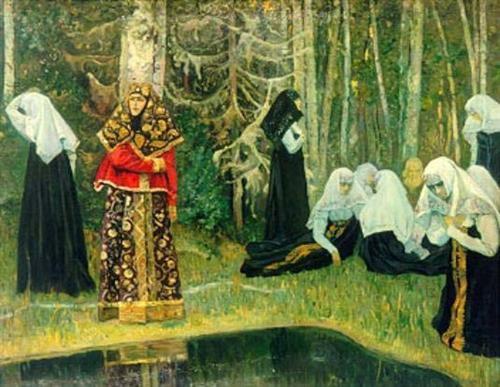One of the most beautiful legends of Russian history is the myth of the invisible city of Kitezh, or Russian Atlantis. With the stories about this sunken city, the concept of “Batyev’s path” is also connected. This is a real existing glade through which you can get to Svetloyar - a lake with a very beautiful and original Russian name.
Literary sources

The legend of the city of Kitezh caused a surge of interest after the publication of the first part of the dilogy of P. I. Melnikov-Pechersky's "In the Woods", which he wrote from 1871 to 1874. In this work, the customs, legends, and life of the Old Believers are described in detail, from which, in fact, the “Svetoyarsk cult” began. Among the literary treasures of the Old Believers-runners (Bespopovskoe direction) there is a monument, created presumably in the XVIII century, under the name "Kitezh Chronicler", in which Batyev’s path is mentioned. This is a secret road given to the khan by one of the traitors. The book has a second name - "The book, the verb Chronicler." It consists of two parts. And, if its first section has a historical foundation, the second is devoted to the "earthly paradise" and is an apocryphal monument. In other words, the story, where the city of Kitezh and the Batyev’s trail directly appear, is, in essence, an unreliable and legendary retelling, passed from mouth to mouth.
Real events
The parable tells of Kitezh as a mysterious place where true believers await the Second Coming of Christ. Some sources say that the gates of Kitezh will not open before the appearance of the Messiah, and therefore the city is sometimes called the "messianic". The first part of the book tells the story of the really existing Prince Vladimir and Suzdal Yuri Vsevolodovich (1188-1238), who lived at that time and in the place referred to in the literary monument. He was the third son of the Great Duke Vsevolod, famous for his fertility, the Big Nest. They called him that because of the large number of wives and children. Although Yaroslav the Wise outnumbered the Vladimir ruler in the number of children.
The best representatives of the princely family
Prince Yuri was a righteous and pious man. The Bogoroditsky monastery in Nizhny Novgorod was founded by him. In 1645, he was canonized by the Russian Orthodox Church. There are many legends associated with this historical figure, according to which he was the founder of Maly Kitezh on the banks of the Volga (later Gorodets), Yuryevets and Big Kitezh. A sad and beautiful myth is captured the death of the prince on the battlefield. Baty compartment to his head and, according to tradition, traveled with her all the battlefield. When the parts of the dismembered body were laid nearby, they fused, leaving no trace. At the same time, the deceased's right hand was raised like a living one. He is credited with several statements and predictions.
The destroyer of the Russian land
According to legend, Batu, pursuing the retreating prince, captured and ravaged Small Kitezh. From the inhabitants of the city, he learns about the existence of Greater Kitezh and sends his army there. But on the road an impassable wall rises a forest. Batu learns from the prisoner where to cut the clearing. So the Batyev path appears . This is a real road. Fiction and reality intertwine here. A beautiful and completely unguarded city appeared before the eyes of the Tatar-Mongol army. The inhabitants were engaged in a passionate prayer for salvation, addressed to God. And in front of the astonished conquerors, numerous fountains began to beat from the earth, and the city went under water. The last to disappear was the golden cross of the main temple. In place of the newly existing city, the oval lake Svetloyar appeared in the correct form . Kitezh has become invisible and inaccessible to enemies. The Lord heard the prayers of the townspeople and covered them. Batu stepped back before this miracle.

Source of inspiration
Svetloyarsk Lake itself, its origin is a topic for debate and speculation. Its correct form gives reason to think that it is a meteorite crater. However, many people like a beautiful legend about Kitezh, which speaks of the power of the Russian faith and is something more than a myth. She inspired talented people to create wonderful musical and artistic works that were included in the treasury of Russian culture (the above epic and the famous Rimsky-Korsakov opera). Numerous canvases by artists inspired by this theme are delightful. The main essence of the legend is that the invisible beautiful holy city is shown only to the true righteous, and a person is sinful from the beginning.